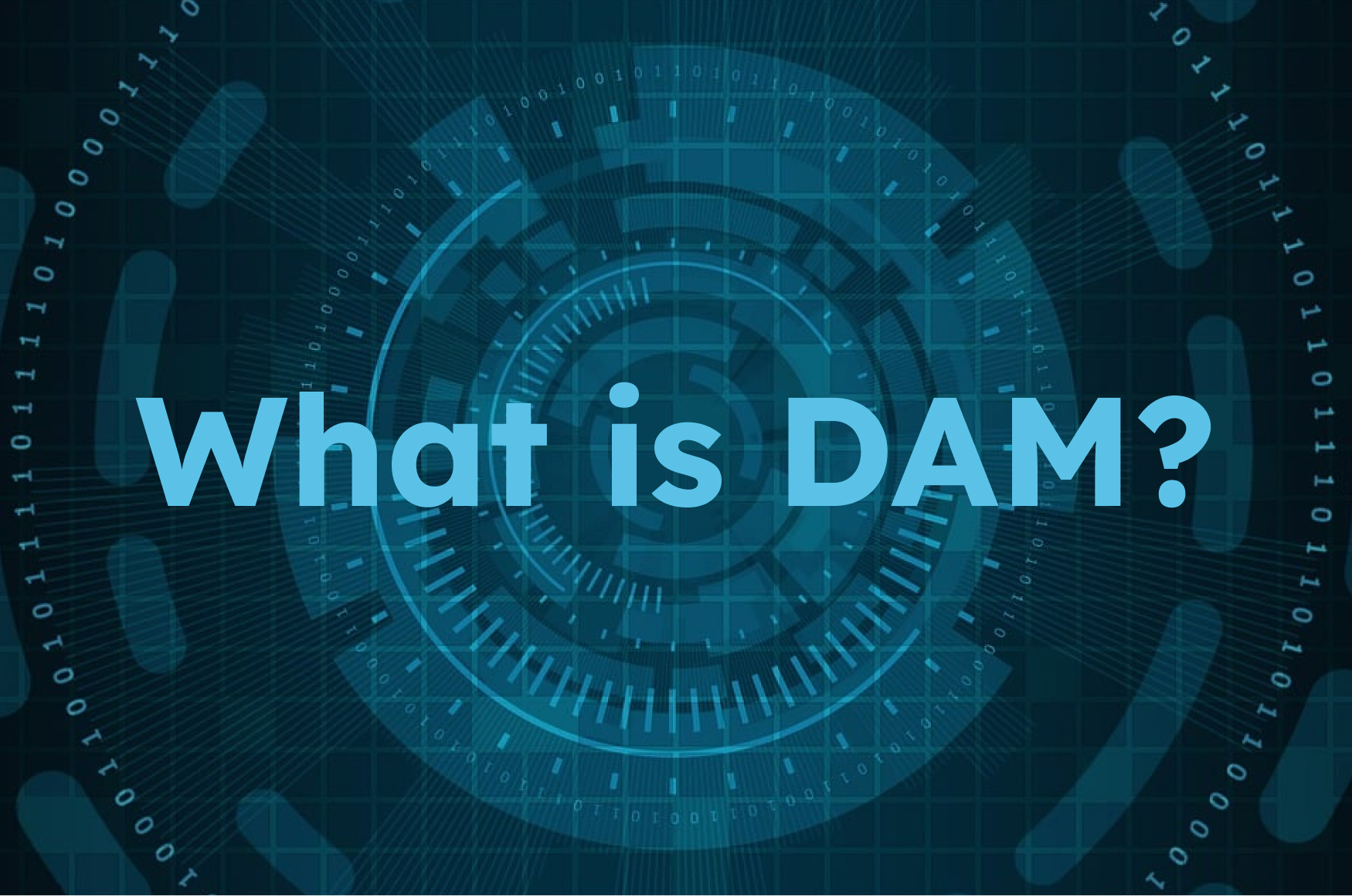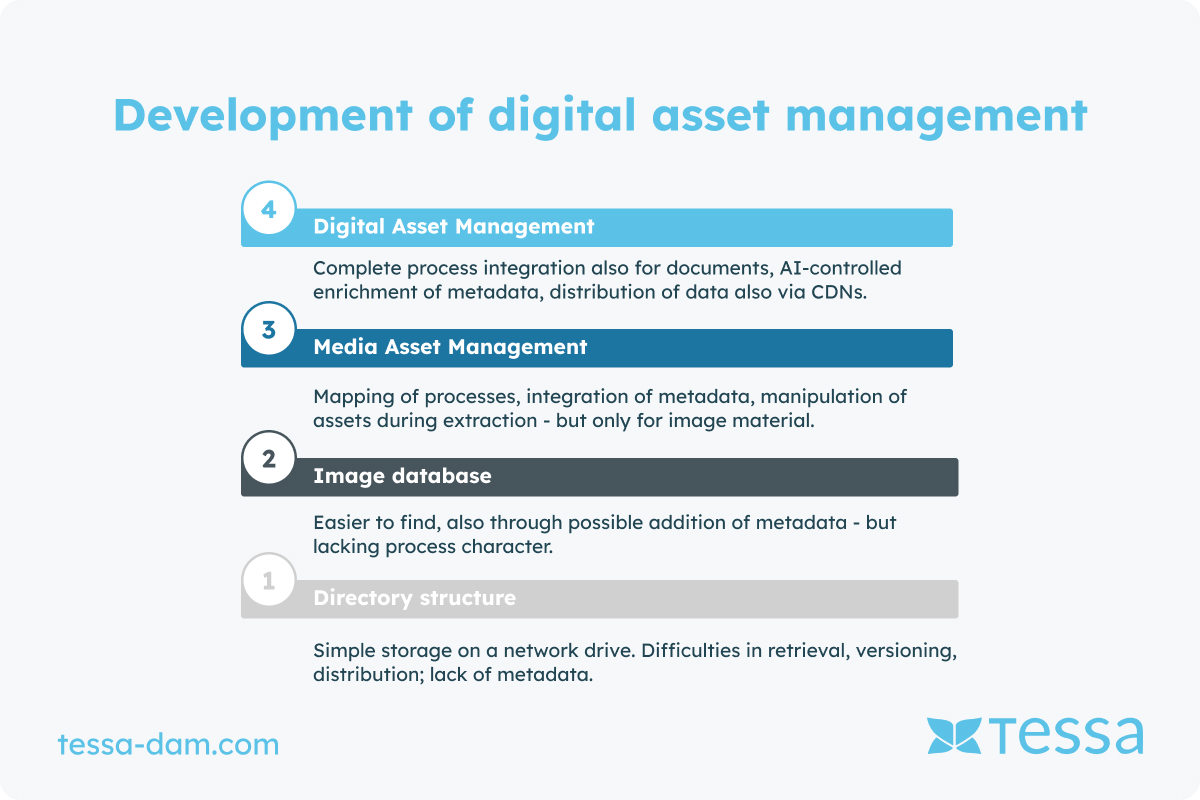Definition of Digital Asset Management (DAM)
Digital Asset Management (DAM) refers to the process of managing, organizing, and delivering digital resources within an organization or company. These digital resources can encompass a variety of file formats, such as images, videos, audio files, documents, and other media. The primary goal of DAM is to facilitate access to these digital assets, ensure their reusability and security, and efficiently manage the entire lifecycle of digital content. By implementing a Digital Asset Management system, your company can save time and resources by creating a central platform to organize, search, edit, and share digital content.
Overview of digital asset management and media asset management: definitions and context
In addition to Digital Asset Management (DAM), this domain also includes Media Asset Management (MAM), which specifically focuses on managing media content such as videos, audio, and images. While DAM covers the breadth of digital resources, MAM specifically focuses on managing media content as needed in industries like broadcast, film production, and media. It is essential to understand the differences between the two concepts and choose the right solution for specific requirements.
To further explain the terms and concepts surrounding Digital Asset Management, we have compiled a list of the most common terms. This includes terms such as:
- Image database, image archive,
- Media database,
- Media Library Software,
- Digital Media Management,
- Digital Asset Software, DAM System (Digital Asset Management),
- MAM System (Media Asset Management),
- Product Asset Management, Media portal,
- Mediaportal, and
- Marketing Asset Management.
While these terms are often used interchangeably, it is important to consider the specific functions and applications of each solution to find the optimal software solution for individual requirements.
The importance of Digital Asset Management (DAM) in today's digital landscape
With the exponential growth of digital content and resources, companies of all sizes and industries face the significant challenge of efficiently managing, organizing, and utilizing them. DAM provides a centralized solution that enables companies to effectively manage the ever-growing pool of digital assets. DAM offers crucial functions for organizing, managing, and delivering digital assets for various purposes. In an era where digital assets play a central role in the business environment, DAM has become an essential tool for managing the complexity and scope of digital resources, thereby strengthening the success and competitiveness of businesses.
The basics of Digital Asset Management
What are digital assets?
Digital assets are media files that encompass a wide range of formats, including images, graphics, videos, audio recordings, documents, presentations, and other multimedia content. They are used in various business contexts to communicate information, market products, establish brand identities, or support business processes.
Images: Include photos in various forms as well as drawings.
Videos: Encompass image videos, webinars, instructional videos, and product videos.
Audio: Contains podcasts for end consumers as well as audio material for video productions such as jingles.
Presentations (e.g., PPT files): Documents used to present information and visually represent it.
PDFs: Portable Document Format files that represent a document independently of the operating system and software.
Logos: Graphic symbols or icons representing a brand's identity.
Banners: Graphics or advertisements designed to draw attention to specific content.
Text files: Documents or text files used for communicating information.
3D visualizations provide an exciting extension for Digital Asset Management (DAM). They allow the representation of products in virtual environments, particularly relevant for industries such as architecture, design, and e-commerce. By integrating 3D visualizations into a DAM system, companies can enhance their digital assets with immersive and interactive content, significantly improving product presentation, communication, and experience.
The management and organization of these digital resources are crucial to maximize their value and effectively utilize them. Learn more about the term Digital Assets here.
Why is it important to manage digital assets?
Managing digital assets is crucial for several reasons:
Efficiency: Structured management allows for quicker and easier retrieval of your digital assets, speeding up workflows and increasing productivity.
Consistency: Organized management ensures that all users can access current and approved versions of digital assets, ensuring consistency in communication and brand management.
Security: Effective management of your digital assets helps ensure their security and integrity by controlling access and protecting sensitive information.
Reusability: Well-organized digital assets can be easily reused, saving time and resources and increasing efficiency in creating new content.
Compliance: Managing digital assets allows your company to comply with legal requirements and industry-specific regulations by ensuring that all content meets the relevant standards.
Challenges of managing without DAM
Without a Digital Asset Management (DAM) system, your company faces a range of challenges in managing digital assets:
Lack of findability: Without structured metadata and tags, digital assets can be challenging to find, resulting in wasted time and frustration.
Inadequate accessibility: Scattered digital assets make access difficult and impair collaboration.
Inconsistency in versioning: Managing different asset versions without a unified system can lead to conflicts.
Difficulties in rights management: Without a DAM system, controlling access rights is complicated, posing security risks.
Inefficiency in collaboration: Lack of platforms for sharing slows down workflows and hampers team communication.
Risk of data loss: Without structured backup, there is an increased risk of losing important assets.
The functions of Digital Asset Management (DAM)
The essential functions of DAM include:
Central storage: DAM provides central storage for digital assets, improving findability and accessibility.
Intelligent search: DAM systems offer powerful search and navigation features that enable targeted searches and efficient navigation.
Media distribution: DAM enables efficient distribution of digital media to internal and external stakeholders.
Workflows: DAM systems support the automation and management of workflows related to digital assets.
Rights and roles: Managing rights and roles ensures security and compliance.
Media portals: simplify the distribution and management of digital content for employees, press, and sales teams.
AI functions: DAM can benefit from artificial intelligence to improve asset management.
The Benefits of Digital Asset Management (DAM)
Digital Asset Management (DAM) offers a variety of benefits to your company, positively impacting efficiency, quality, costs, risk mitigation, and collaboration. The essential benefits of DAM are explained in detail below:
Efficiency improvement: Centralized storage and organization of your digital assets enable quick access and reduce the time spent searching for resources. Employees can work more effectively and access the right assets at the right time, increasing productivity.
Consistency and quality assurance: DAM ensures the use of current and approved assets, avoiding inconsistencies and maintaining quality standards. This helps maintain a coherent brand image and strengthens customer trust.
Cost savings: By automating and reusing assets, administrative costs can be reduced, and resource utilization optimized. Less time is required for manual searching and asset management, leading to more efficient use of working hours.
Risk mitigation: Centralized backup and access control in a DAM system protect against data loss, privacy breaches, and compliance violations. Precise control over access to sensitive data can effectively minimize risks.
Improvement of collaboration and workflow: Sharing assets promotes efficient collaboration and communication between different teams and departments. Easy access to relevant content enables teams to work faster and more effectively, increasing overall company productivity.
These benefits make Digital Asset Management an indispensable tool for companies to effectively manage and utilize their digital resources, significantly contributing to the success and growth of the company.
DAM in Enterprises
A Digital Asset Management (DAM) system serves as the central anchor point for all images and documents to be distributed within a company, thus forming the central repository. It ensures that all approved photos, which may be used in websites, apps, catalogs, or brochures, are stored in a DAM. This system manages the original image, which is only needed once, thereby making the exact storage location known to all involved parties. This clear assignment of responsibilities within the company promotes transparent organization.
Furthermore, assets need to be integrated into the DAM system, with some being automatically integrable from other processes. For instance, product datasheets in companies with extensive product portfolios are often automatically generated and require little individual control. User manuals and technical drawings are extracted from previous processes. However, integrating photos from an in-house photography process requires cooperative teamwork. For this purpose, DAM systems like TESSA DAM offer specialized workflows, where a photo initially lands in an input area. Subsequently, the responsible process leader can either further categorize it or request any necessary improvements directly in the DAM. Ideally, approval can be granted without further inquiries. In this sense, a DAM also serves as a tool for process optimization.
An elaborate and intelligent search, granting optimal access to assets for employees, colleagues, and customers, is another essential component. Such a search function reduces inquiries and allows employees to focus on other tasks. Additionally, TESSA DAM offers the possibility to create dynamic searches for asset distribution. By creating profiles, subscribers or recipients are automatically notified when new matching assets become available. This ensures efficient distribution of photos, graphics, and documents.
The distribution of media objects is a central function of a DAM system and offers a variety of options. Depending on requirements, a company's website may require image data and documents as files on a Content Delivery Network (CDN). Conversely, complete URLs need to be stored in the product database of the electrical industry. For customer requests for physical files, such as ZIP files or on an FTP directory, assets can be provided in the desired format—be it JPEG, PNG, or TIFF. This, along with resizing, are core functions of TESSA DAM.
Journalists and advertising agencies often prefer selecting from a larger pool of assets. TESSA DAM provides functionalities to meet such requirements. These include media portals presenting static and dynamic asset collections along with an intelligent search function. The manner in which assets are downloaded by the user—whether in the original format or in a specific resolution and dedicated file format—can be determined accordingly.
To ensure that various DAM users can perform their tasks easily and quickly, the system allows for the allocation of dedicated roles. Thus, for example, a photographer from Portugal and a journalist from the USA can use TESSA DAM in different ways. Rights and roles in TESSA DAM are extremely granularly defined and can be adjusted quickly and easily down to the smallest detail.
DAM in Various Industries
Marketing and Advertising: In the marketing and advertising industry, DAM is essential for managing digital assets such as images, videos, and other marketing materials. A centralized DAM system enables teams to access current versions of assets, improves collaboration and efficiency, and ensures brand consistency across all channels.
Retail: For retailers, DAM plays a key role in managing product images, descriptions, and other digital content needed for online commerce. DAM systems support retailers in synchronizing their product information across various platforms and ensuring a unified shopping experience.
Education: Educational institutions use DAM to organize teaching materials, research documents, and digital archives. DAM facilitates access to learning resources for educators and learners and supports research by improving access to documents and data.
Healthcare: In healthcare, DAM assists in managing patient images, clinical studies, and other sensitive data. By using DAM, healthcare facilities can ensure compliance with data protection regulations and efficiently manage access to critical information.
What is DAM SaaS?
DAM SaaS refers to a delivery method for Digital Asset Management (DAM) where the DAM software is offered as a service over the internet. Companies gain access to a web-based platform hosted and maintained by an external provider. Unlike traditional on-premises solutions, DAM as a Service does not require internal IT infrastructure. Instead, companies can utilize DAM functionality via the internet, enabling faster implementation and scalability. Learn more about this topic in our blog post SaaS vs. On-Premises.
Conclusion
Digital Asset Management with TESSA
Digital Asset Management (DAM) is an indispensable tool for companies in various industries to efficiently manage and utilize their digital resources. By centrally organizing and effectively distributing digital assets, DAM significantly contributes to increasing productivity, improving collaboration, and ensuring the quality of digital content, ultimately strengthening the success and competitiveness of companies. Do you want to be convinced by the features of our DAM solution TESSA? Then book your free demo here with one of our experts.











